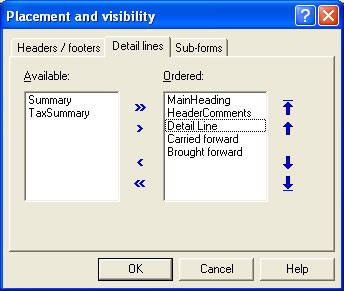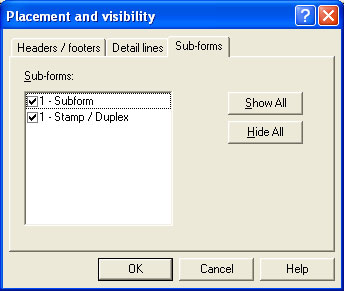|
When a form design becomes complex, some page elements may obstruct
others or may even not fit on the page in the design window. FTDesign
adds page elements to the page in the order you create them. If, for
example, you add a group header after creating a detail line, it can be
difficult to correctly align text to the appropriate header text.
To cater for these situations, FTDesign
allows you to define which page elements are currently visible on
screen and in which order to place those elements. You can control this
from the Placement and visibility option
in the Define menu.
Note: this option has
no influence on the order of page elements produced at run-time.
To adjust the Placement and visibility:
- Select Placement and
visibility from the Define
menu.
- On the Headers / footers
tab:
- Available
- headers and footers in the Available
box will not appear on the form in FTDesign. Although the headers and
footers in the Available box do not appear on the form, they will still
print at run-time.
- Ordered
- headers and footers in the Ordered box
will appear on the form in the same sequence.
- Right/Left arrows
- use the right and left arrows to move headers and footers between the
Available and Ordered boxes.
- Up/Down arrows
- use the up and down arrows to change the header and footer order in
the Ordered box.

- On the Detail lines
tab:
- Available
- detail lines in the Available box will
not appear on the form in FTDesign. Although the details lines in the
Available box do not appear on the form, they will still print at
run-time.
- Ordered
- detail lines in the Ordered box will
appear on the form in the same sequence.
- Right/Left arrows
- use the right and left arrows to move detail lines between the Available
and Ordered boxes.
- Up/Down arrows
- use the up and down arrows to change the detail line order in the Ordered
box.

- On the Sub-forms
tab:
- Sub-forms
- in the sub-forms box check or uncheck the check box to make the
sub-form visible or not visible.
- Show All
- click the Show All button to make all
sub-forms on the form visible.
- Hide All
- click the Hide All button to make all
sub-forms on the form not visible.

|


